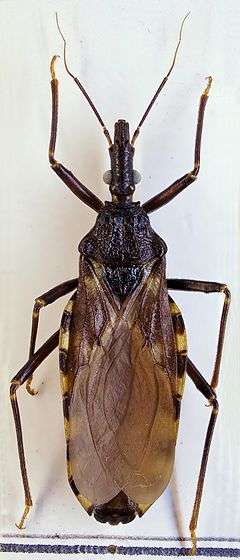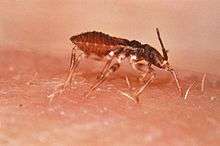Triatoma infestans
| Triatoma infestans | |
|---|---|
 | |
| | |
| Scientific classification | |
| Kingdom: | Animalia |
| Phylum: | Arthropoda |
| Class: | Insecta |
| Order: | Hemiptera |
| Suborder: | Heteroptera |
| Family: | Reduviidae |
| Genus: | Triatoma |
| Species: | T. infestans |
| Binomial name | |
| Triatoma infestans Klug, 1834 | |


Triatoma infestans, commonly called winchuka[1] (vinchuca) in Argentina, Bolivia and Chile, barbeiro in Brazil and also known as "kissing bug" or "barber bug" in English, is a blood-sucking bug (like all the members of its subfamily Triatominae) and the most important vector of Trypanosoma cruzi which can lead to Chagas disease. It is widespread in the Southern Cone countries of South America; that is, in Bolivia, Argentina, Uruguay, Paraguay, Chile, Brazil and Peru. In all these countries T. infestans is almost an exclusively domestic species, except in Bolivia where sylvatic forms have been recorded in rock piles in association with wild guinea pigs. This region has joined the control intervention called Southern Cone Initiative managed by the PAHO.
During the Beagle survey voyage, Charles Darwin noted in his journal for 26 March 1835 having "experienced an attack, & it deserves no less a name, of the Benchuca, the great black bug of the Pampas. It is most disgusting to feel soft wingless insects, about an inch long, crawling over ones body; before sucking they are quite thin, but afterwards round & bloated with blood, & in this state they are easily squashed." Richard Keynes describes this Benchuca as being Triatoma infestans.[2]
See also
External links
| Wikimedia Commons has media related to Triatoma infestans. |
- Information on Triatoma infestans and other members of Triatominae, by Andreas Rose
- Information on Triatominae, by Fernando Otálora-Luna
Notes
- ↑ Teofilo Laime Ajacopa, Diccionario Bilingüe Iskay simipi yuyayk'ancha, La Paz, 2007 (Quechua-Spanish dictionary)
- ↑ Keynes 2001, p. 315
- Keynes, Richard (2001), Charles Darwin's Beagle Diary, Cambridge University Press, retrieved 2011-08-23